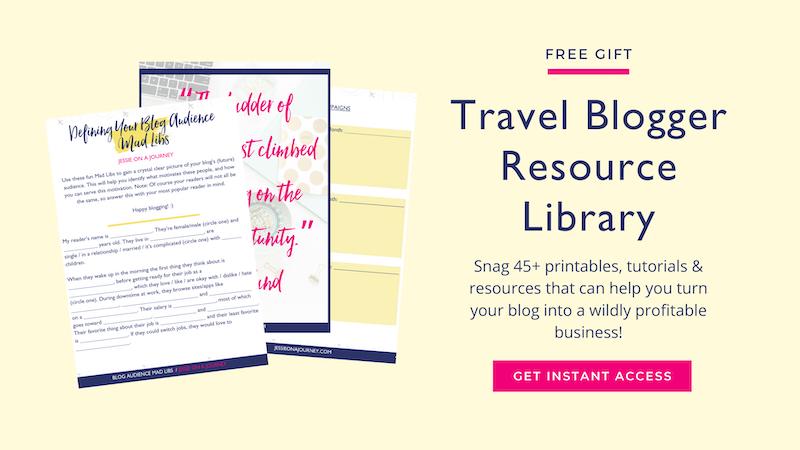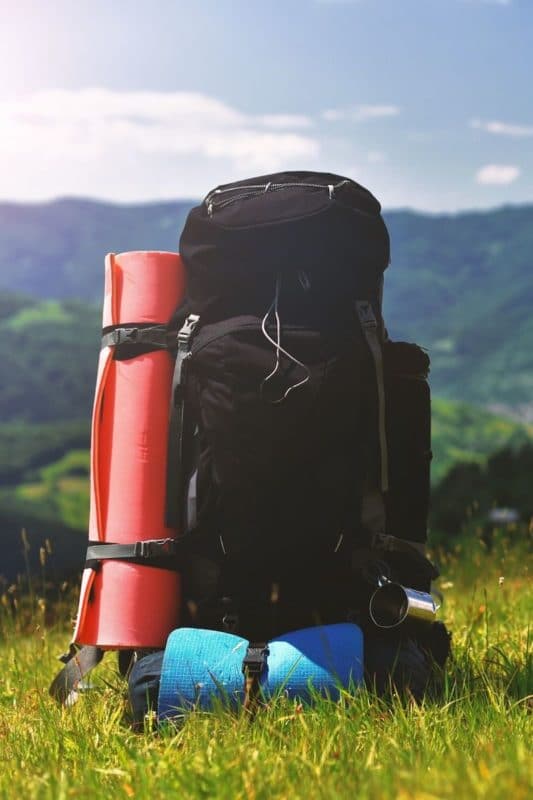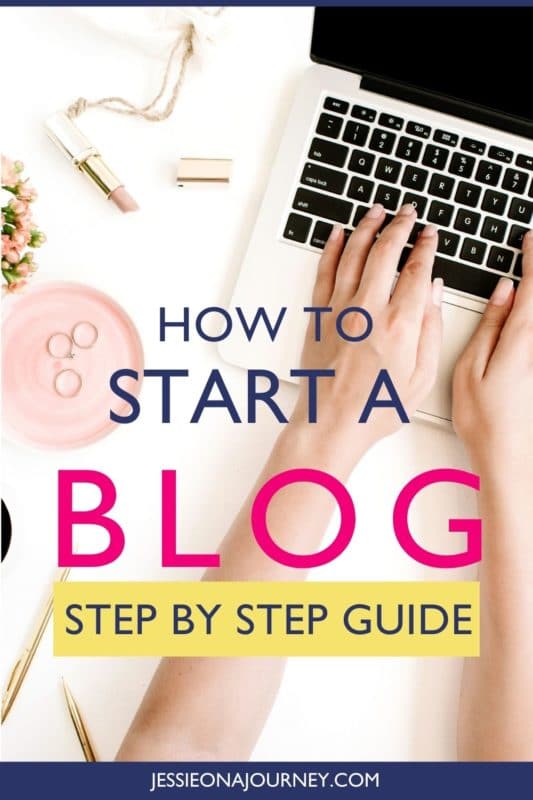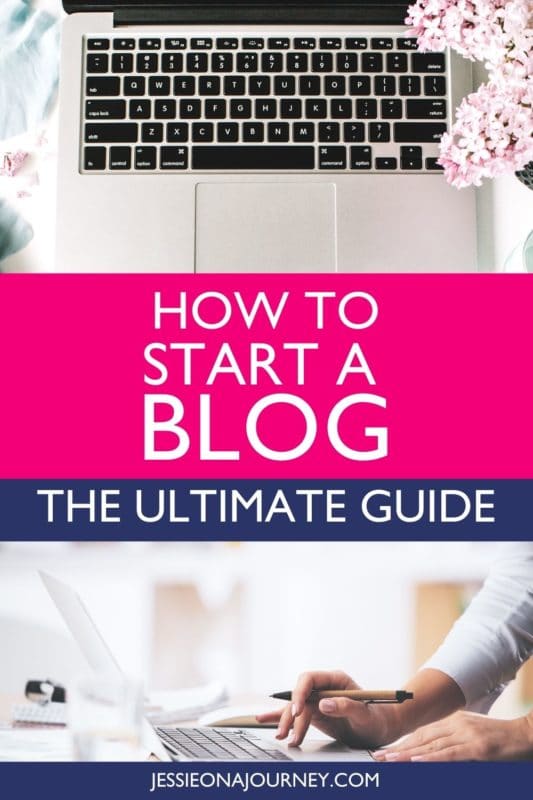How To Start A Travel Blog And Make Money Step-By-Step
Curious about how to start a travel and make money?
This guide can help!
There is a lot to understand when it comes to building a profitable blogging business — especially when you’re just starting out.
To help, I break things down step-by-step below. By the end of the post, you’ll understand:
- Things you need to do before launching your blog
- How to set up your website in the best possible way
- Ways to grow your website traffic and get readers to your content
- What to actually write about on your travel blog (content plan template included!)
- How to monetize your site and boost your travel blogging income
- And more!
Note: This post on how to start a travel blog and make money contains affiliate links to trusted partners I think you’ll love!
Free Travel Blogging Course
But first, before we dive into this in-depth guide on starting a blog and how to become a travel blogger and make money, I invite you to grab a seat in my free travel blogging course.
If you’re curious how to start a travel blog and get paid, this 4-day video course will show you step-by-step.
By the end, you’ll have a solid plan for how to create the profitable blogging business of your dreams!
Things To Do Before Setting Up Your Blog
Before you start creating content, it’s important to:
- Sort out the legal side of your blogging business
- Figure out how you’ll do your bookkeeping and accounting as a blogger
From there, you can move on to the creative side of things. One of the most important parts of understanding how to make money as a travel blogger is actually spending time solidifying your brand.
Branding your blog means you’ll know exactly who you help and how, as well as why you’re blogging and what you’re working toward.
With a solid brand, it’ll be much easier to come up with blog post ideas, social media posts, digital products to sell, and more. Plus, it’ll help you avoid writer’s block as a blogger.
Here are a few questions to get you started with branding your blog:
- Who do you want to help and how through your blog?
- What are your values? As in, how do you want to show up for people?
- Why are you blogging?
- What are your goals with your blog?
- What kinds of messaging can you use to convey your brand?
Additionally, you can grab access to my free Travel Blogger Resource Library, which features a branding workbook as well as a fun audience mad libs worksheet, among other helpful printables and tutorials that can make travel blogging for beginners easier.

How To Start A Travel Blog Step-By-Step
Step #1: Choose your domain name.
My advice for new travel bloggers is to really think long and hard about this, as if you decide to change it later it will be a huge pain.
Your travel blog post ideas should fit seamlessly with your domain name and your overall brand.
A few considerations when determining your domain name:
- Do you want to have more of a personal blog or more a magazine-style blog? For instance, Jessie on a Journey vs Epicure & Culture.
- Is there a keyword you can put in the blog name to make the main topic clear? For example, Solo Female Travel Society.
- Is your blog destination based? For instance, All About NYC.
To make sure that a certain domain name is available, you can use this free tool from Bluehost:
Step #2: Choose & purchase your hosting provider.
Website hosting is one of the most important purchases you’ll make, as it can impact the speed and user experience of your website.
Honestly, it doesn’t matter how great your travel content ideas are if you have a slow site that doesn’t load for your visitors.
Moreover, you’ll want a host with great customer service to help out when you inevitably run into issues.
While I personally use and love Flywheel, I realize this can be quite pricey for newer bloggers.
If you’re just starting out and want something reliable yet budget-friendly, I suggest checking out Bluehost and Siteground.
Make sure to also consider the long-term pricing of their packages and what will best fit your budget.
Getting set up is quick and easy, too. For instance, with Bluehost you’ll simply:
- Click “Get Started” on their homepage
- Enter in your desired domain name (or enter in your existing domain if you’re moving a site over) and click “Next”
- Fill in your personal information and choose your hosting plan
- Tip: The longer you pay for upfront typically the cheaper it’ll be annually
- Also, I personally recommend skipping any extras, as you can always use plugins, a few of which I’ll recommend below
- Create your password on the next page
- Login to Bluehost to install WordPress, which you can do by scrolling to the “MOJO Marketplace” section and choosing “One-Click Installs”
- Choose “WordPress” (unless you’re using a different content management system, which I don’t recommend) and click “Start”
- Choose your domain, then click “Check Domain” to ensure it is assigned and pointing to your account
Note that Bluehost (and most other hosts) offers extensive documentation with visuals on how to get set up quickly and correctly if you need further assistance.
Most website hosts also provide website backups. Make sure your host does — or choose a plugin or tool to do this for you.
Personally, I go an extra step and save a copy of my website backup to my computer every Friday.

Step #3: Choose your theme.
Now for the fun part!
Once you’re set up technically, it’s time to design the site that will house your incredible travel content.
I highly recommend skipping the free themes — which don’t typically offer support — and opting for a paid theme.
You can peruse the Envato Marketplace for a wide range of beautiful themes.
Personally, I use the Beaver Builder theme on Jessie on a Journey as well as X Theme on my NYC photo tour site. I love both themes and would highly recommend either of them.
Pro tip:
Forget heavy themes with loads of bells and whistles, like moving photo slideshows on the homepage.
Usually, a simple but functional theme will be faster and offer a better user experience to visitors.
Step #4: Get set up technically for safety & speed.
Along with writing engaging blog content, one of the biggest priorities you should have when it comes to your blog is making sure it is fast.
Not only will this offer a better user experience, but it can also help your content rank higher in search engine rankings.
My absolute favorite plugin for speeding up my website is WPRocket.
Real talk:
As soon as I set up the plugin I saw an immediate increase in site speed.
Just a few of its many site speed enhancing features include:
- Page & browser caching
- Lazy-loading of images
- Sitemap preloading
- Database optimization
- Cloudflare compatibility
- And more!
Speaking of Cloudflare, this is the second tool I highly recommend installing if you want a speedy and secure site.
The free tool helps optimize your site while also screening visitors to make sure they’re not malicious bots or something else bad.
Speaking of speed, it’s also worth it to do some research on the best laptops for blogging. A good laptop can be expensive, but it can really help increase your efficiency.

Step #5: Install additional plugins.
There is a plugin for almost every issue you run into and any adjustment you want to make to your website.
A few of my favorites include:
Grow by Mediavine. This plugin adds social sharing buttons to your travel blog posts, and also allows you to add clickable Tweets and Pinterest-optimized graphics to your content.
ConvertPlus. This is my go-to plugin for creating beautiful and highly-customizable popups, smart bars, and slide-ins that can help grow your email list and increase your blogging income.
Updraft Plus. This plugin allows you to create backups of your website.
Akismet. This plugin helps eliminate spammy comments and messages coming through your contact form.
Beaver Builder. I use this plugin to create beautiful high-converting landing and sales pages, like this one sharing about my Travel Blog Prosperity membership community.
Cookie Notice. This plugin lets people know that your blog uses cookies and lets them agree to this policy.
Schema Pro. This plugin allows you to easily add Schema Markup to your website to help improve SEO.
Step #6: Set up your analytics tracking.
To have a successful travel blog, you need to be able to monitor what is working and what isn’t.
There are two free tools I suggest setting up to track your blog’s analytics.
These include:
Google Analytics. This tool helps you learn about the demographics and behaviors of your website visitors.
Moreover, you’ll gain important insights into how people arrive to your blog and interact with your content.
Google Search Console. On the other hand, this tool helps you better understand how your content is performing in Google search results.
With this information, you can tweak your content strategy moving forward, and even edit previously published blog posts to help increase their chances of ranking in search results.
Furthermore, this tool lets you know when there are errors on your site that need to be fixed.

Step #7: Publish your important pages.
We’re almost ready to write a blog post.
Before doing that, it’s recommended to publish a few important pages, including your:
About Page. Introduce yourself to your blog visitors and let them know what they’ll get out of being a reader, including your top travel blog topic ideas and categories.
If you need help writing your about page, I’ve got a template you can use in my free blogging resource library.
Work With Me Page. This is especially helpful if you want to land paid brand collaborations.
Privacy Policy. This page spells out how you collect, use, and store the data of your website visitors and is required by law.
Website Terms & Conditions. Another legal page, though this one shares the rules that visitors must agree to in order to use your website.
Disclaimer. This legal page helps limit your liability; for instance, if you recommend a restaurant in a blog post and then someone goes and gets food poisoning they can’t hold you responsible.
Pro tip:
If legal pages make you nervous, my friend and lawyer Lisa Fraley offers a number of plug-and-play templates on her website.
Step #8: Write your first blog post.
It’s time to put those creative storytelling skills to work and write your first blog post!
You can use this blog content planner template to get organized and create an intentional publishing schedule for your posts.
By the way, if you’re curious how to write blog articles fast, having a content plan is very helpful. You can honestly plan a year of content in one week if you understand SEO.
Additionally, this list of travel blog post ideas should keep you inspired for a while! It’s especially helpful if you’re not 100% sure what to blog about yet.
Now, as you create your content plan, I highly recommend considering what types of content can bring in profits so you can add those in.
We’ll go over that more below, but for now, check out this video on how to monetize a blog content series:
How To Promote Your Travel Blog Organically
There are many ways to increase your blog traffic without spending money on advertising, like:
Understand Search Engine Optimization (SEO) To Increase Blog Traffic
In my opinion, the best way to help your blog posts organically get found is by optimizing your content for Search Engine Optimization (SEO).
Now, SEO starts with having a speedy site that offers a great user experience.
My secret weapon for this is WPRocket, which I discussed above. If you want a fast site I highly recommend this plugin.
Moreover, you’ll want to optimize your blog posts for specific keywords that people search — so that your posts get shown to them!
For this, I use a tool called Keysearch, which allows you to pinpoint a main keyword you can realistically rank for and optimize your content for that keyword.
Additionally, the tool shows you supporting keywords, common questions, and important sub-topics to include in your blog post to help it rank higher in search engine results.
If this sounds confusing, don’t worry, as Keysearch offers tutorials on how to best use their powerful software.
Bonus:
You can click here and use code “JESSIEONAJOURNEY” for 20% off!
Here is a quick Keysearch tutorial showing how I use the tool to find niche keywords I can actually rank for:
Additionally, here are few other important SEO tips:
Optimize your blog posts for long-tail keywords. These are keywords that are longer — three or more words — and more specific, which makes them easier to rank for.
For example, it’ll be easier to rank for “Best family-friendly hotels in New York City” than “NYC hotels”.
Consistently write about the same topics. This not only makes it clear to your audience what you’re an authority on, but also Google — meaning it’ll be easier to rank for them.
Interlink your content. Building backlinks — both from other sites (external backlinks) and from your other posts (internal backlinks) — is great for SEO.
In fact, building backlinks for a post can help it rank more easily. While it takes work to build backlinks from other sites, you can control your internal backlinks.
Pro tip:
When creating your content plan, plan posts that easily link together! For instance, a blog post on the Best Hikes In Upstate New York can link to posts on the individual hikes themselves.
Update your old blog posts. Having a relevant, factual, and up-to-date website is an important part of any SEO strategy.
Build Blog Traffic Using Social Media
I know Instagram, TikTok, and other platforms can be frustrating, but it is possible to enjoy social media if you approach it the right way.
First of all, don’t try to be everywhere. Instead, focus on one platform at a time and create a repeatable strategy that works before moving on to another. For instance, if you create a TikTok for bloggers strategy or a Pinterest strategy that you can come back to every week, it’ll be an easier and more enjoyable experience.
Additionally, when choosing which platforms to be active on, consider your goals.
For instance, if you want to grow your blog traffic, a platform like Pinterest where people are actually searching for answers to their questions and then clicking away from the platform would be a great option.

Get New Readers Through Collaboration
Whether you’re a new blogger or you’ve been blogging for a while, you can work with other creators — and even affiliates and brands — to cross-promote each other’s content or products.
This allows you to gain visibility, get new blog followers, and increase your traffic.
Pro tip:
Put together a small group of bloggers in your niche that can cross-promote each other’s content. You can have everyone join a private Facebook group where you all post new content on the wall to be shared by others.
For more ideas, check out my guide on how to grow your blog through collaboration.
Promote Your Blog At Events To Gain Visibility
Don’t forget about opportunities to promote your blog during virtual or in-person events!
For instance, if you’re speaking or hosting a presentation, create a slide that showcases a relevant opt-in freebie and a link to grab it.
This allows you to grow your email list while empowering your community. You’ll then be able to let those on your email list know when new content publishes.
By the way, this guide can help you understand how to create opt-in freebies for your blog if this concept is new to you.

Speaking of which…
Share New Content With Your Email List
Wondering what to send to your email list?
Here’s one idea:
Make sure you let your email list know when new content publishes.
Remember, these people are your most dedicated community members; your VIPs. They gave you their digital phone number — which takes a lot more than simply hitting “like” or “follow” on social media.
Pro tip:
When letting your email subscribers know that a new post publishes, don’t just share the title and link and call it a day.
Instead, utilize storytelling email marketing by teasing the content and sharing stories! Here are some prompts for your emails:
- Why did you write the post?
- How will reading the post benefit your community?
- Did what you share in the post have a before-and-after effect on you? What was it?
Weaving in personal stories and making the benefits of reading your blog post clear can really help increase clicks to your content!
How To Make Money Blogging
Let’s start off this section by answering the question:
How do beginner bloggers make money?
When you’re first starting out, it’s smart to focus on branding your blog, creating valuable content, getting blog followers, and overall growing your blog.
It’s also smart to map out your blogging goals and set deadlines to meet them — such as taking your blog full-time within a year or optimizing your site so that you can sell your blog for profit.
Make Money Travel Blogging With Affiliate Marketing
This all being said, one smart way to monetize your blog and get on your way to becoming a professional travel blogger is creating a smart affiliate strategy.
Choose travel blog topics that promote your favorite affiliate partners and encourage readers to purchase through your affiliate link.
A few tips for succeeding with affiliate marketing and monetizing your travel blog include:
Focus on affiliate products you already use and love.
This first step to seeing success with affiliate marketing for travel bloggers is to consider the products you already stand by. This is because the easiest products to promote will be the ones you already have experience with.
Take inventory of what products you currently use that you’d feel good about promoting — and that would benefit your audience.
This will be a great place to start when deciding what affiliate programs to join.

Join affiliate programs that have high payouts.
While Amazon is convenient because it has so many different products listed, the payout amount is very low.
I recommend instead focusing on programs that have a high payout so that it is worth your time to create content around them.
Pro tip:
The best commissions are recurring — meaning you continue to earn an affiliate commission for as long as your referral is a paying customer of the product.
A few brands offering recurring affiliate commission include ZenMate VPN, Backblaze, and Stencil.
Share affiliate links in content that attracts buyers.
Simply sprinkling affiliate links into your content willy-nilly is not a strategy.
Instead, combine SEO with affiliate marketing and optimize your content for “buyer-intent keywords” — as in, words and phrases that people search when they have their credit card in hand ready to purchase.
For instance, you know someone searching for the “best affordable hiking backpacks under $100” is looking to buy a backpack. The word “best” is a very common buyer-intent keyword to add to a search phrase to attract buyers.
Install Skimlinks. Additionally, you can use a tool like Skimlinks to automatically turn your regular links into affiliate links. This can be helpful if you want to start making money right away without implementing a complicated strategy.
By the way, installing Skimlinks is one of my favorite quick win strategies to grow your blog fast.
Want more? Check out this video:
Bonus Ideas For Monetizing Your Travel Blog
A few other ideas for how to be a travel blogger and make money include:
- Going on paid press trips
- Creating an online course using Teachable (tip: here is how to validate an online course idea before creating it)
- Writing and monetizing a blog series
- Selling digital products
- Selling services and experiences, like day tours in your home city and multi-day tours abroad
- Opening an online shop using Sellfy
- Making money with webinars
- Becoming an affiliate for Ultimate Bundles and including one of your digital products in an upcoming bundle
- Monetizing your email list using ConvertKit (30-day free trial; no credit card required!)
- Pitching a paid brand collaboration
- Creating a profitable automated email sequence
- Creating a free challenge that grows your email list and income
- Sending different types of emails focused on sales
- Running display ads with Mediavine
- Coming up with travel post ideas that promote affiliate partners offering recurring revenue
- Getting featured in the media as a freelance writer
- And more!
Bonus:
Here are 13 ways to increase your travel blogging income.
Additionally, this video shares 14 profitable product ideas for bloggers. I highly recommend launching a product at some point in your blogging career, as doing this can really help you have more control over your earnings:
The #1 Way To Increase Your Travel Blogger Salary
If you want to earn a full-time blogger salary, here is an important note:
One of the main things that keeps travel bloggers from being profitable is not implementing revenue streams.
Please do not make the mistake of thinking that simply creating more content will lead to income. Yes, your content can be profitable — as long as you have an actual profit plan.
My suggestion:
No matter what revenue streams you choose, implement one at a time and really work to set it up for success.
It may seem daunting to, say, create an online course or an affiliate marketing content plan; however, if you break up your revenue stream implementation into steps or milestones it will be a lot less daunting.
Give yourself time and space to test and tweak.
Check in to see what is working — and what isn’t — with your strategy so you can truly increase your travel blogger salary and experience how to earn money from a travel blog.

How To Start A Travel Blog Without Traveling
Before ending this guide on how to launch your site and how to earn money from a travel blog, I want to discuss a question that comes up often:
Is it possible to start a travel blog if you don’t travel full time — or even frequently?
The answer:
Absolutely!
Because here is the thing:
Your hometown — while it may not be a travel destination to you — can be an interesting destination for someone else.
Moreover, not all travel blog content needs to be narrative guides about your travel experiences or lists of your personal top picks from a place.
Here are a few alternative travel blog ideas:
- A travel blog where you interview other travelers
- A travel blog where you research pioneering travelers to share their stories
- A travel blog where you publish recipes from around the world
I encourage you to think outside the box and get creative with your own travel blog focus. What is ultimately important is that you’re sharing your passion in a way that helps others.
What tips would you add to this guide on how to start a travel blog and make money?



